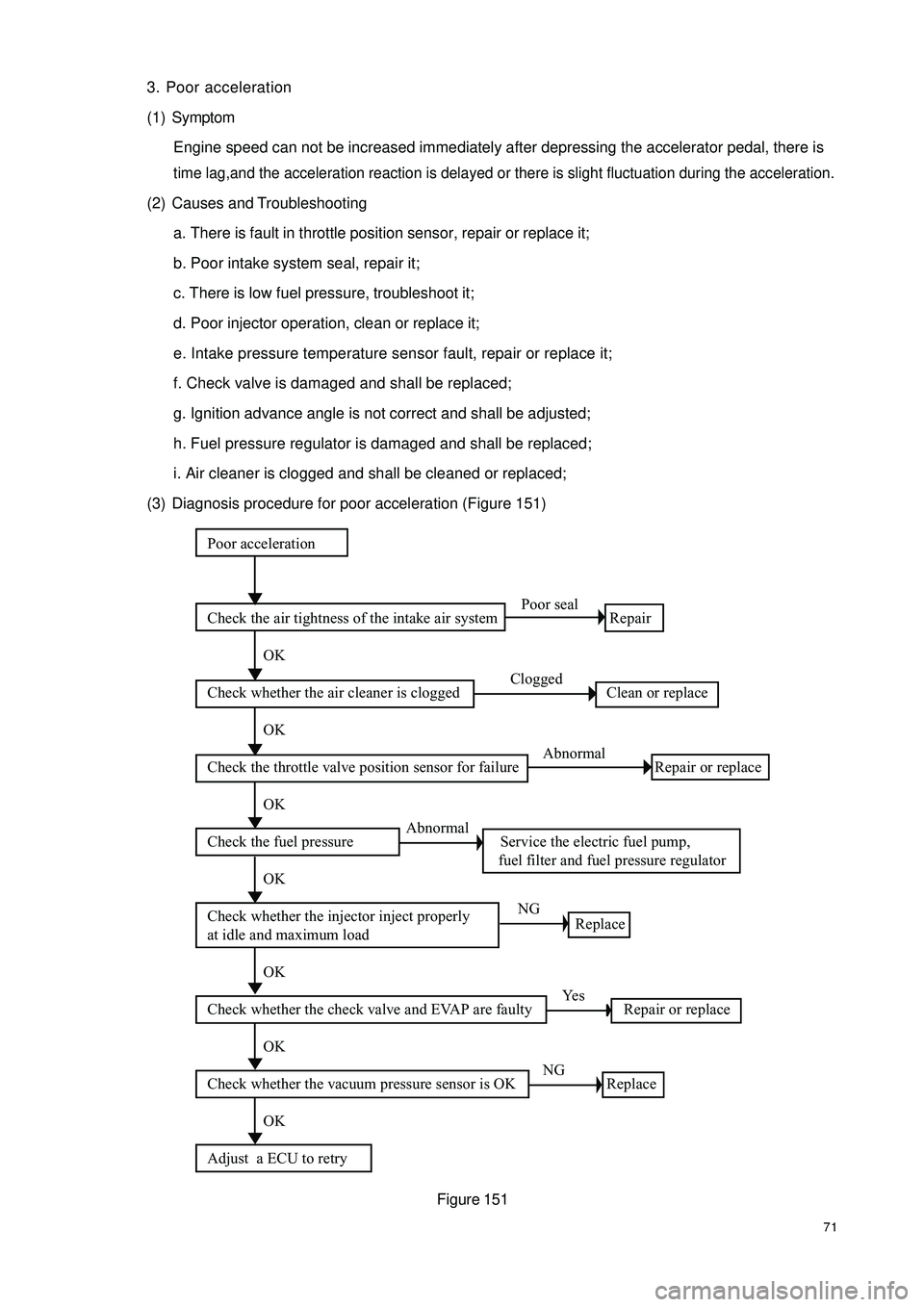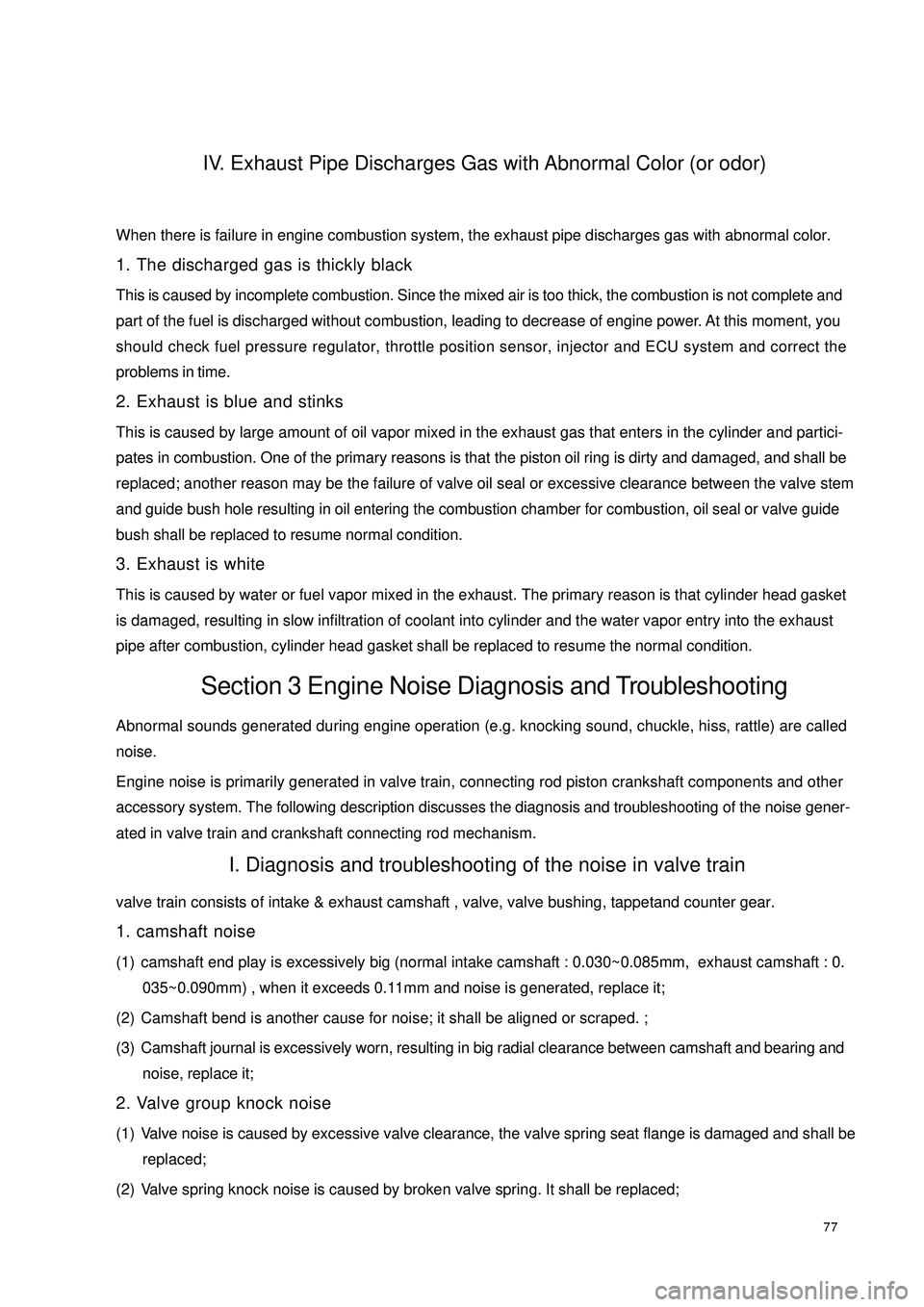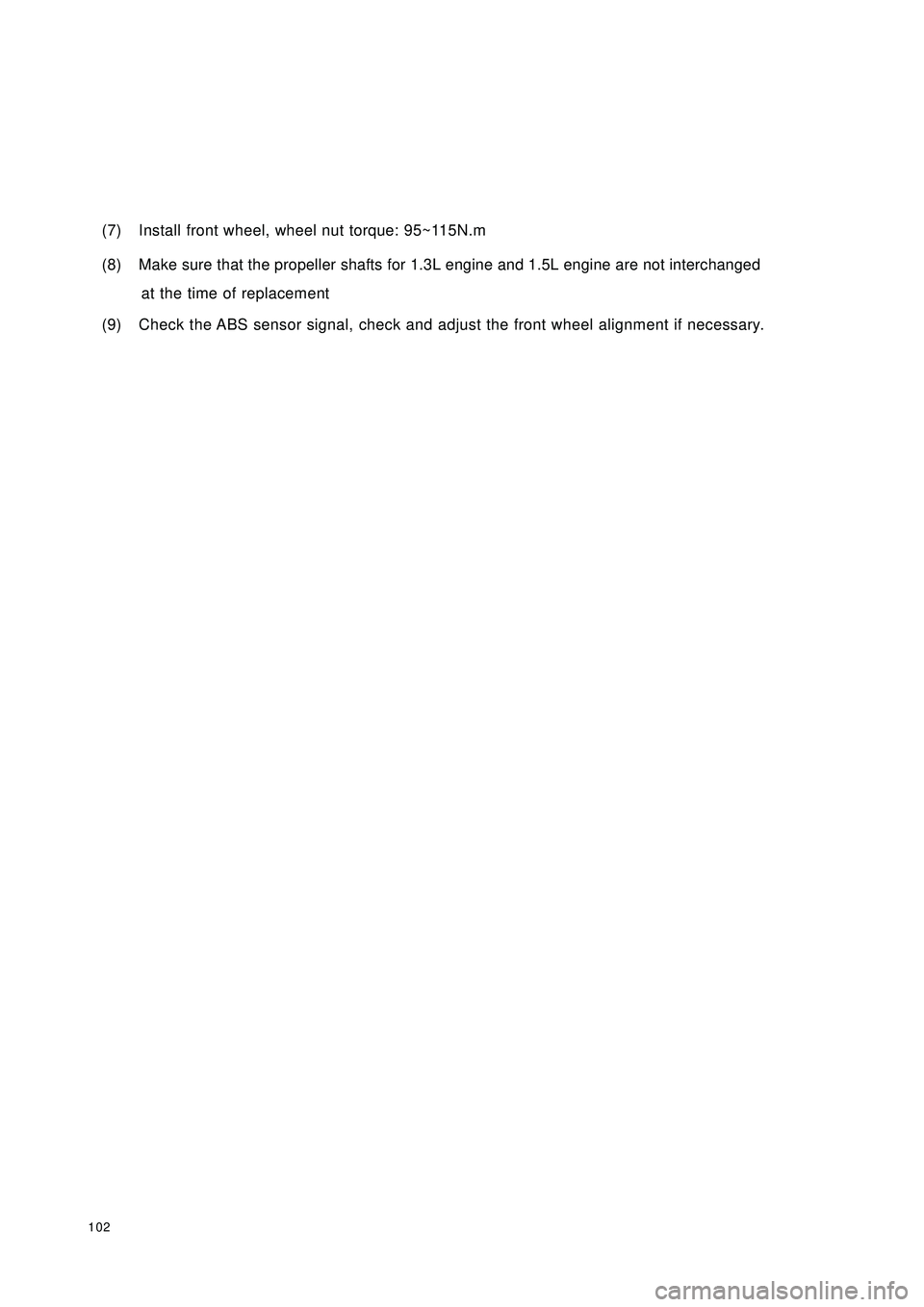check engine GEELY CK 2008 Owner's Guide
[x] Cancel search | Manufacturer: GEELY, Model Year: 2008, Model line: CK, Model: GEELY CK 2008Pages: 392, PDF Size: 38.86 MB
Page 78 of 392

713. Poor acceleration
(1) Symptom
Engine speed can not be increased immediately after depressing the accelerator pedal, there is time lag,and the acceleration reaction is delayed or there is slight fluctuation during the acceleration.(2) Causes and Troubleshooting
a. There is fault in throttle position sensor, repair or replace it;
b. Poor intake system seal, repair it;
c. There is low fuel pressure, troubleshoot it;
d. Poor injector operation, clean or replace it;
e. Intake pressure temperature sensor fault, repair or replace it;
f. Check valve is damaged and shall be replaced;
g. Ignition advance angle is not correct and shall be adjusted;
h. Fuel pressure regulator is damaged and shall be replaced;
i. Air cleaner is clogged and shall be cleaned or replaced;
(3) Diagnosis procedure for poor acceleration (Figure 151)
Figure 151Poor acceleration
Check the air tightness of the intake air system Poor seal
Repair
OK
Check whether the air cleaner is clogged Clogged
Clean or replace
OK
Check the throttle valve position sensor for failure Abnormal
Repair or replace
OK
Check the fuel pressure Abnormal
Service the electric fuel pump,
fuel filter and fuel pressure regulator
OK
Check whether the injector inject properly
at idle and maximum load NG
Replace
OK
Check whether the check valve and EVAP are faulty Yes
Repair or replace
OK
Check whether the vacuum pressure sensor is OK NG
Replace
OK
Adjust a ECU to retry
Page 80 of 392

737. Unstable idle or engine shut off at hot status
(1) Symptom
Idle speed is normal during the cold start and becomes unstable at hot status, idle speed is too
low or engine is shut off.
(2) Causes and Troubleshooting
a. Idle is adjusted too low, adjust it to normal condition;
b. Water temperature sensor fault, repair or replace it;
c. Poor injector operation or big injection variation, repair or replace it;
d. Poor water temperature switch and thermostat operation, repair or replace it;
e. Check valve is damaged and needs to be replaced.
Figure 152Rough ildling, easy for engine shut off
Check whethe the air tightness of the intake system is good Poor
Troubleshooting
OK
Check idle control valve for operation Inoperative
Disassemble or replace
Operative
Reset the initial idle speed
Check the spark plug Poor
Adjust the clearance or replace
OK
Check the fuel pressure NG
Check the electric pump, fuel
pressure regulator and fuel filter
OK
Check the injector NG
Replace
OK
Check the pressure sensor NG
Replace
OK
Check the cylinder compression pressure NG
Disassemble the engine
OK
Check and adjust the valve clearance
Page 81 of 392

748. Idle speed too high at hot status
(1) Symptom
The engine runs at fast idle during cold start and remains fast idle at hot status, leading to excessively fast
idle.
(2) Causes and Troubleshooting
a. The initial idle value is not properly adjusted,
b. High system fuel pipeline pressure, need to be adjusted;
c. Water temperature sensor fault, repair or replace it;
d. Water temperature switch and thermostat fault, repair or replace it;
e. Idle control valve fault, repair or replace it;
f. Throttle is binding and not tightly closed, repair or replace it;
g. Fuel evaporation control valve is always open, repair or replace it;
h. Speed sensor fault, repair or replace it.
9. Idle fluctuation
(1) Symptom
when idling, the engine speed fluctuates.
(2) Causes and Troubleshooting
a. Intake pressure temperature sensor fault, repair or replace it;
b. Check valve is damaged and needs to be replaced;
c. Water temperature sensor , water temperature switch and thermostat is poorly coordinated, repair,
adjust and troubleshoot them;
d. Oxygen sensor fault, need to be replaced;
e. Spark plug poor connection, repair or replace it;
f. Idle control valve and its control circuit fault, repair or replace it;
g. Idle switch is not closed, need to be repaired.
Page 84 of 392

77IV. Exhaust Pipe Discharges Gas with Abnormal Color (or odor)When there is failure in engine combustion system, the exhaust pipe discharges gas with abnormal color.
1. The discharged gas is thickly black
This is caused by incomplete combustion. Since the mixed air is too thick, the combustion is not complete and
part of the fuel is discharged without combustion, leading to decrease of engine power. At this moment, you
should check fuel pressure regulator, throttle position sensor, injector and ECU system and correct the
problems in time.
2. Exhaust is blue and stinks
This is caused by large amount of oil vapor mixed in the exhaust gas that enters in the cylinder and partici-
pates in combustion. One of the primary reasons is that the piston oil ring is dirty and damaged, and shall be
replaced; another reason may be the failure of valve oil seal or excessive clearance between the valve stem
and guide bush hole resulting in oil entering the combustion chamber for combustion, oil seal or valve guide
bush shall be replaced to resume normal condition.
3. Exhaust is white
This is caused by water or fuel vapor mixed in the exhaust. The primary reason is that cylinder head gasket
is damaged, resulting in slow infiltration of coolant into cylinder and the water vapor entry into the exhaust
pipe after combustion, cylinder head gasket shall be replaced to resume the normal condition.Section 3 Engine Noise Diagnosis and TroubleshootingAbnormal sounds generated during engine operation (e.g. knocking sound, chuckle, hiss, rattle) are called
noise.
Engine noise is primarily generated in valve train, connecting rod piston crankshaft components and other
accessory system. The following description discusses the diagnosis and troubleshooting of the noise gener-
ated in valve train and crankshaft connecting rod mechanism.I. Diagnosis and troubleshooting of the noise in valve trainvalve train consists of intake & exhaust camshaft , valve, valve bushing, tappetand counter gear.
1. camshaft noise
(1) camshaft end play is excessively big (normal intake camshaft : 0.030~0.085mm, exhaust camshaft : 0.
035~0.090mm) , when it exceeds 0.11mm and noise is generated, replace it;
(2) Camshaft bend is another cause for noise; it shall be aligned or scraped. ;
(3) Camshaft journal is excessively worn, resulting in big radial clearance between camshaft and bearing and
noise, replace it;
2. Valve group knock noise
(1) Valve noise is caused by excessive valve clearance, the valve spring seat flange is damaged and shall be
replaced;
(2) Valve spring knock noise is caused by broken valve spring. It shall be replaced;
Page 92 of 392

85Part II ChassisChapter 1 Transmission Control DeviceSection 1 Transmission Control DeviceDescription on Transmission Control DeviceThis model is equipped with lever and cable transmission control devices, respectively used for 1.3L and 1.5L
engine, both of their gears are: 5 forward gears + 1 reverse gear.PROBLEM SYMPTOMS TABLEUse the table below to help you find the cause of the problem. The numbers indicate the priority of the likely
cause of the problem. Check each part in order. If necessary, replace these parts.Section 2 Lever Type Transmission Control DeviceComponentsSymptom
1. Tra nsmission c ontrol de vic e se le ctor (position
changing) cable (improperly assembled)
2. Ca ble or rela te d pa rts worn
3. Ca ble a sse mbly (incorrec t)
4. T r a ns mis s ion ( f a ult y)
1. Transmission control device selector (position
changing ) cable (improperly assembled)
2. Ca ble or rela te d pa rts worn
3. Ca ble a sse mbly (incorrec t)
4. Transmission (faulty) Transmission out of gea r
Transmission shift difficultControl lever Assembly
Dust Proof Cover
Botton Panel
Assembly of body
Dust Proof Cover Retainer
Control Pull Rod AssemblySuspected Area
Page 97 of 392

90Chapter 2 Accelerator PedalSection 1 Accelerator PedalComponents
Replacement1. Remove the accelerator cable
Loosen the set nut attaching the accelerator cable to the accelerator
cable bracket on the engine, remove the accelerator cable from
the throttle valve rocker arm
2. Remove accelerator pedal
(1) Remove two set nut between the accelerator pedal
and vehicle body
(2) Separate the accelerator cable
3. Detach the accelerator cable
4.Install the accelerator cable and accelerator pedal assembly in the reverse order of the
Notice:
(1) Accelerator pedal assembly fixing bolt torque: 20~25N.m
(2) Properly adjust the position of the accelerator cable set screw to ensure the adequate
tension of the accelerator cable
(3) Check whether the accelerator control is flexible and reliableCowl BaffleHole Plug
Accelerator
Pedal Assembly Accelerator CableAdjusting NutConnect
The Engineabove procedure.
Page 98 of 392

91Chapter 3 Clutch Control SystemSection 1 Clutch Control SystemClutch operating system descriptionThis model is equipped with hydraulic and cable clutch control system, respectively used for 1.3L engine
1.5L engine.PROBLEM SYMPTOMS TABLEUse the table below to help you find the cause of the problem. The numbers indicate the priority of the likely
cause of the problem. Check each part in order. If necessary, replace these parts.Section 2 Clutch Cable Control MechanismComponentsSympto m Sus pe cte d Are a
1. Clutc h pe da l position (Too low)
2. Control mec ha nism (Stagna tion)
3. Clutc h pe da l fre e stroke (too la rge)
C lut c h doe s not r e le a s e 1. H ydr a ulic pipe line ( A ir in line )
1. Control system (Incorrect assembly & adjustment)
2. Clutc h asse mbly (Fa ulty) Clutch noisyC lut c h s lipsConnect The
Clutch Fork Clutch Cable
Assmbly
Adjusting NutCowl Baffle
Clutch and Brake
Pedal Assembly
Page 109 of 392

102(7) Install front wheel, wheel nut torque: 95~115N.m
(8) Make sure that the propeller shafts for 1.3L engine and 1.5L engine are not interchanged
at the time of replacement
(9) Check the ABS sensor signal, check and adjust the front wheel alignment if necessary.
Page 141 of 392

134On-vehicle inspection1. check the drive belt
Observe the drive belt for excessive wear and cordline wear. Replace the drive belt if necessary.
Hint: Cracks on the rib side of a belt are considered acceptable. If missing chunks from the
ribs are found on the drive belt, it should be replaced.
2. Bleed the power steering system
(1) Check the fluid level
(2) Jack up the front of the vehicle and make sure it is safe
(3) Rotate the steering wheel
a. With the engine off, turn the steering wheel from LH limit position to RH limit position several
times
(4) Release the jack and lower the vehicle
(5) Start the engine, run the engine at idle for a few minutes
(6) Turn the steering wheel to left or right limit position and keep it there for 2 - 3 seconds, then turn the
steering wheel to the opposite limit position and keep it there for 2 - 3 seconds. Repeat it several
times.
(7) Shut off the engine, check for foaming or emulsification in the reservoir. If there is foaming or
emulsification, bleed power steering system repeatedly
(8) Check the fluid level and for leakage
2. Check the fluid level
(1) Park the vehicle on a level surface
(2) With the engine stopped, check the fluid level in the reservoir. Add power steering fluid AT F
DEXRON if necessary.
Hint: the fluid level should be within the range of lowest level and highest level
(3) Check for foaming or emulsification, if there is, drain the power steering systemNormalAbnormal
Page 142 of 392

135Replacement1. Drain the power steering system fluid
2. Remove the power steering high and low pressure pipe
3. Loosen the union screw of the high and low pressure pipe on the steering gear assembly, loosen the pipe
clip.
4. Loosen the drive belt
5. Remove the power steering pump with bracket assembly from the engine
Remove the 4 attaching bolts between the steering pump belt bracket and the engine6.Install the power steering pump bracket assemblySecure the power steering pump bracket assembly to the engine,
The torque of the M10 bolt is 45~79N.m, the torque of the M8 bolt is 16~26N.m7. Install the drive belt, make sure the installation position is correct
8. Install the power steering high and low pressure pipe(1)Connect the union thread of the high and low pressure pipe to the steering gear,
torque: 19~33N.m
(2) Use the retaining clip to secure the low pressure pipe to the cowl baffle panel of the body
(3)Connect the union thread of the high pressure pipe to the power steering pump,
torque: 19~33N.m
(4) Connect the union thread of the low pressure pipe to the reservoir, torque: 19~33N.m
9. Bleed the power steering pipeline system, check the pipeline system for leakage
10. Check the oil reservoir inner fluid level